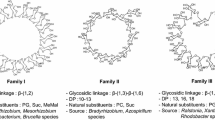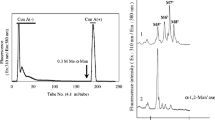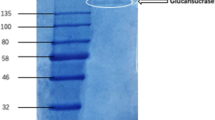Summary
A glycan was obtained from the periplasmic space ofRhizobium trifolii cells by saccharose-osmotic shock method. This glycan was composed of only β-1,2-linked glucose, having no end groups (reducing and non-reducing) and branching points. It was concluded that this glucan has a structure of unbranched cyclic form.
When the cyclic β-1,2-glucan was added to the seedlings of white clover as a host plant withR. trifolii, it promoted not only the infection thread formation but also the nodule formation. In the culture medium containing the cyclic β-1,2-glucan, cells were found agglutinated during the middle logarithmic phase of growth, and their morphological changes were recognized as cell elongation or swelling in the middle region of a cell when observed in scanning electron microscope (SEM).
Similar content being viewed by others
References
Abe M and Higashi S 1979 The infectivity ofRhizobium trifolii into a minute excised root of white clover. Plant and Soil 53, 81–88.
Bender M L and Komiyama M 1978 Cyclodextrin chemistry; Reactivity and structure, Concepts in organic chemistry, 6. Springer-Verlag, New York.
Bergersen F J 1974 Formation and function of bacteroids.In The biology of nitrogen fixation. Ed. A Quispel. North-Holland Publishing Co., Amsterdam. Oxford. pp. 473–489.
Van Brussel, A A N, Costerton J W and Child J J 1979 Nitrogen fixation byRhizobium sp. 32H1. A morphological and ultrastructural comparison of asymbiotic and symbiotic nitrogen-fixing forms. Can. J. Microbiol. 25, 352–361.
Dedonder R A and Hassid W Z 1964 The enzymatic synthesis of a (β-1,2-)-linked glucan by an extract ofRhizobium japonicum. Biochim. Biophys. Acta 90, 239–248.
Fåhraeus G 1957 The infection of clover root hairs by nodule bacteria studied by a simple glass slide technique. J. Gen. Microbiol. 16, 374–381.
Gorin P A J, Spencer J F T and Westlake D W S 1961 The structure and resistance to methylation of 1,2-β-glucans from species of Agrobacteria. Can. J. Chem. 39, 1067–1073.
Hakomori S 1964 A rapid permethylation of glycolipids and polysaccharides catalyzed by methylsulfinyl carbanion in dimethyl sulfoxide. J. Biochem. 55, 205–208.
Higashi S 1966 Electron microscopic studies on the infection thread developing in the root hair ofTrifolium repens L. infected withRhizobium trifolii. J. Gen. Appl. Microbiol. 12, 147–156.
Higashi S and Abe M 1978 Phage induced depolymerase for exopolysaccharide of Rhizobiaceae. J. Gen. Appl. Microbiol. 24, 143–153.
Higashi S and Abe M 1980 Promotion of infection thread formation by substances from Rhizobium. Appl. Environ. Microbiol. 39, 297–301.
Higashi S and Abe M 1980 Scanning electron microscopy ofRhizobium trifolii infection sites on root haris of white clover. Appl. Environ. Microbiol. 40, 1094–1099.
Higashi S, Abe M and Yamane G 1971 The influence of plant hormones on the formation of infection thread into root hair ofTrifolium repens L. byRhizobium trifolii K102. Rep. Fac. Sci. Kagoshima Univ. (Earth Sci. Biol.) 4, 53–61.
Keele B B, Hamilton Jr P B, and Elkan G H 1969 Glucose catabolism inRhizobium japonicum. J. Bacteriol. 97, 1184–1191.
Lippincott J A and Lippincott B B 1975 The genus Agrobacterium and plant tumorigenesis. Annu. Rev. Microbiol. 29, 377–405.
Ljunggren H and Fåhraeus G 1961 The role of polygalacturonase in root-hair invasion by nodule bacteria. J. Gen. Microbiol. 26, 521–528.
Napoli C and Albersheim P 1980Rhizobium leguminosarum mutant incapable of normal extracellular polysaccharide production. J. Bacteriol. 141, 1454–1456.
Vincent J M 1970 The cultivation, isolation and maintenance of Rhizobia.In A Manual for the Practical Study of Root-Nodule bacteria. IBP Handbook No. 15. Blackwell Scientific Publications. Oxford and Edingburgh. 1–13.
Vincent J M 1970 The assessment of nodulation and nitrogen fixation. In:ibid.. 73–104.
York W S, McNeil M, Darvill A G and Albersheim P 1980 Beta-2-linked glucans secreted by fast-growing species of Rhizobium. J. Bacteriol. 142, 243–248.
Zevenhuizen L P T M and Scholten-Koerselman H J 1979 Surface carbohydrates of Rhizobium. I. β-1,2-glucans. Antonie van Leeuwenhoek J. Microb Serol. 45, 165–175.
Author information
Authors and Affiliations
Rights and permissions
About this article
Cite this article
Abe, M., Amemura, A. & Higashi, S. Studies on cyclic β-1,2-glucan obtained from periplasmic space ofRhizobium trifolii cells. Plant Soil 64, 315–324 (1982). https://doi.org/10.1007/BF02372514
Received:
Revised:
Issue Date:
DOI: https://doi.org/10.1007/BF02372514




